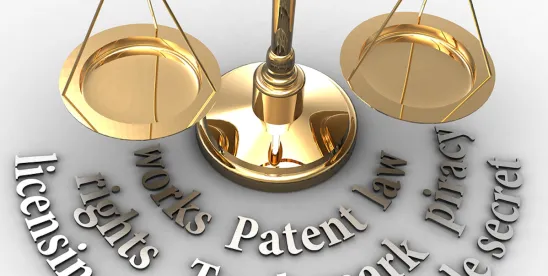In Ioengine, LLC v. Ingenico Inc. No. 2021-1227, 2021-1331, 2021-1332 (Fed. Cir. May 03, 2024), the case addresses the patentability/validity of three patents. In particular, this case discusses the application of the printed matter doctrine during inter partes review, the treatment of newly introduced claim constructions on appeal, and the PTAB’s anticipation and obviousness determinations.
Background
Ingenico Inc. filed petitions seeking inter partes review of U.S. Patent Nos. 8,539,047, 9,059,969, and 9,774,703. The PTAB instituted review of all three patents and concluded that claims 1-21, 23-25, and 27-28 of the ’047 patent, 1-2, 4-8, 13-16, 19-21, 24-25, and 27-29 of the ’969 patent, and 55, 57-63, 67-72, 74, 77-78, 81-87, 89, 92-98, 100, 103-104, 106-112, 116-121, 123, and 126-129 of the ’703 patent were unpatentable.
Ioengine, LLC appealed all three PTAB decisions, challenging the PTAB’s application of the printed matter doctrine, as well as, its anticipation and obviousness analysis.
Issue(s)
Whether a proposed claim construction is forfeited if not presented initially during IPR.
Whether the PTAB erred in making its anticipation determinations.
Whether the PTAB erred in the application of the printed matter doctrine.
Whether the PTAB erred in making its obviousness determinations.
Holding(s)
Ioengine forfeited its proposed claim construction by not presenting it to the PTAB during IPR.
The Federal Circuit affirmed the PTAB’s determinations as to all claims, except 4 and 7 of the ’969 patent and 61-62 and 110-111 of the ’703 patent.
The PTAB erred in applying the printed matter doctrine because the claim terms at issue are not directed to printed matter.
The Federal Circuit affirmed the PTAB’s obviousness determinations.
Reasoning
In relation to Ioengine’s introduction of a new claim construction on appeal, the Federal Circuit noted that they “retain case-by-case discretion whether to apply waiver” but they have routinely “held that a party waives an argument that it failed to present to the [PTAB] because it deprives the court of the benefit of the [PTAB’s] informed judgment.” Ioengine argued that the proposed construction, which they introduced for the first time to the Federal Circuit, “embod[ies] the same concepts” as the construction presented to the PTAB. However, the Federal Circuit disagreed, reasoning that “[r]equiring a terminal to take responsive action differs meaningfully from requiring either the terminal or the portable device to take responsive action.” As such, the Federal Circuit found that Ioengine forfeited its proposed claim construction by failing to introduce it during IPR.
In relation to the PTAB’s anticipation determinations, Ioengine argued that the PTAB erred in concluding that a prior art reference anticipated certain challenged claims in the challenged patents. First, Ioengine argued that the reference failed “to disclose an interactive user interface even under the [PTAB’s] construction” and that the reference’s “disclosure of pressing a number on a separate keypad involves no interaction with the interface elements.” And second, Ioengine argued that the reference failed “to disclose ‘second program code’ providing a ‘communications node’ on the terminal and ‘third program code’ providing a ‘communications node’ on the portable device.” However, the Federal Circuit found these arguments to be unpersuasive, citing both the petitioner’s expert testimony and the challenged patents’ own written description. Accordingly, the Federal Circuit held that there was substantial evidence to find that the challenged patents were anticipated, and thus, the PTAB did not err in finding them invalid.
In relation to the PTAB’s application of the printed matter doctrine, Ioengine argued that the PTAB “incorrectly applied the printed matter doctrine to accord no patentable weight to certain claim limitations that recite ‘encrypted communications’ and ‘program code.’” The Federal Circuit starts their analysis by noting that they “have long recognized that certain ‘printed matter’ falls outside the scope of patentable subject matter under U.S. patent law,” further stating “‘printed matter’ historically referred to claim elements involving actual ‘printed’ material, today the doctrine has expanded to include any information claimed for its communicative content, regardless of medium.”
The Federal Circuit explained that a two-step test is used to determine whether the printed matter doctrine is correctly applied to the claims at issue. In the first step, the Federal Circuit “determine[s] whether the limitation in question is directed toward printed matter,” noting that a “limitation is printed matter only if it claims the content of information.” The Federal Circuit indicates that “‘[o]nly if the limitation in question is determined to be printed matter’ do we proceed to the second step, which asks ‘whether the printed matter nevertheless should be given patentable weight.’”
During IPR, the PTAB applied the printed matter doctrine to claims 4 and 7 of the ’969 patent, which are directed to “communication network node[s].” In particular, the PTAB found that the limitation “‘“encrypted communications” claims only communicative content, i.e., printed matter’ because it found ‘nothing in the claim that requires anything beyond sending and receiving data, even if the data is in an encrypted form.’” Thus, the PTAB “concluded that the limitation should be afforded no patentable weight.”
The Federal Circuited disagreed and reasoned that “printed matter is matter that is claimed for its communicative content—i.e., the content specifically being communicated.” And noted that the “fact that there is a communication itself is not content; content is what the communication actually says.” The Federal Circuit further reasons that “[p]rinted matter encompasses what is communicated—the content or information being communicated—rather than the act of a communication itself.” The Federal Circuit goes on to explain that they had previously found FDA labels, medical instructions, and numbers on wristbands to be printed matter, and “unlike those examples … the encrypted communications here are not being claimed for any content that they are communicating.” Therefore, the Federal Circuit found that the claimed “encrypted communications” did not constitute printed matter.
Similarly, the PTAB “declined to afford patentable weight to the ‘program code’ limitations recited in claim 7 of the ’969 patent and claims 61-62 and 110-111 of the ’703 patent.” The PTAB determined that “‘program code’ [] is not entitled to patentable weight” because “the recital of ‘downloading’ of program code [] is limited to downloading (sending or transmitting) the code, which is a communication, and no other function is recited in the claim.” The PTAB further determined that “program code” “is ‘printed matter’ because it claims the content of the information that is downloaded.”
However, the Federal Circuit again disagreed with the PTAB’s application of the printed matter doctrine, reasoning that “‘program code’ is not claimed for its communicative content; no informational content is claimed.” The Federal Circuit goes on to explain that because no specific code is being claimed, the process or step of downloading “program code” falls outside the scope of the printed matter doctrine.
Finally, the Federal Circuit notes that “[b]ecause ‘encrypted communications’ and ‘program code’ are not being claimed here for the content they communication, they are not printed matter,” and thus, “[t]he inquiry stops there; if the claim element is not printed matter, we need not consider whether it has a functional or structural relation to its substrate.”
Lastly, in relation to the obviousness determination, Ioengine argued that “a skilled artisan would not have been motivated to combine the cited prior art references,” and if a skilled artisan were to combine such references, the combination would be based on impermissible hindsight. However, the Federal Circuit was unpersuaded by this argument pointing again to the petitioner’s expert testimony and portions of the cited prior art references themselves “to conclude that a skilled artisan would have been motivated to combine” the cited references.
In conclusion, the Federal Circuit reversed the PTAB’s determinations of unpatentability as to claims 4 and 7 of the ’969 patent and 61-62 and 110-111 of the ’703 patent due to the incorrect application of the printed matter doctrine, and further, affirmed the PTAB’s determinations as to the unpatentability of the other claims of the Challenged Patents.



 />i
/>i

